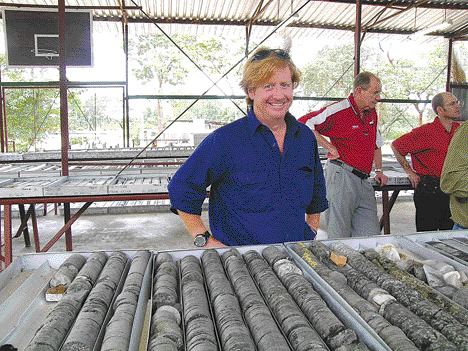While the market initially reacted harshly to news from Equinox Minerals (EQN-T, EQXMF-O) regarding rising capital costs at its Lumwana copper project in Zambia, with time, the market came to see the revised costs in a more favourable light and sent the company’s stock rebounding.
Nearly 11% of their value was shaved from Equinox shares following the June 28 news of a 39% increase in capital costs at Lumwana. But seven days later, shares began to recover, reclaiming 8% over July 5 and 6.
Equinox shares closed out the first week of July at $1.31, after trading at some of the heaviest volumes of any miner over the course of the previous two weeks.
While the latest estimates for preproduction capital costs at Lumwana came in higher than many investors were expecting — at US$762 million, costs were up US$213 million from a previous estimate of US$549 million — the company says there are benefits contained in the increase.
Equinox’s vice-president of investor relations, Kevin van Niekerk, says the new figures include a maximum price guarantee on the construction of the project, and upfront financing for the whole mining fleet (the previous estimate did not include financing for the fleet).
Van Niekerk also points to gains made by the Zambian currency — the kwacha — against the U.S. dollar (it is up roughly 35% against the greenback over the past year) as a contributing factor.
In a report, Raymond James analyst Tom Meyer adds that a “significant” contingency cost of US$95 million is included in the capital costs.
The most striking detail about the revised costs, however, is the guaranteed maximum price.
On June 29, Equinox and joint venture Ausenco-Bateman agreed on the terms of the engineering, procurement and construction (EPC) contract for the process plant and related infrastructure.
The guaranteed maximum price has been set at US$381 million with commissioning scheduled to be complete by the end of the first quarter of 2008. And while that price tag does include some of the expected “fat” that guaranteed pricing entails, it offers considerable security to investors, van Niekerk says.
“In an environment of capital blowouts,” he says — pointing to recent announcements of doubling capital costs at some Alberta oilsands projects, “to have a number that is effectively capped is of real value and that is being understood by analysts and some of their colleagues in the market.”
While the Street gradually found less to be pessimistic about regarding Equinox’s costs, analysts say the market is still skittish about the likelihood of share dilution.
There is an assumption in the market that Equinox will have to issue more shares to raise the funds needed to meet its capital costs.
But Equinox president and CEO Craig Williams says the company is in no hurry to turn to the market for revenue, and that such a scenario is only one option.
“With respect to further additional capital required, there are a number of different capital market and corporate financing alternatives available to Equinox,” Williams said in a press release. “As the company is currently adequately funded following the major capital raising earlier this year, Equinox will assess these options at the appropriate time.”
Van Niekerk points to the 22-million-lb. indicated and inferred U3O8 resource at the Lumwana project as one potential source of alternative revenue, and also highlighted the fact that the company’s latest financing was a non-brokered deal that raised US$30 million.
Pushed into the background amidst the commotion was the doubling of the mine life at Lumwana and the discovery of a series of prospective anomalies stretching over a 2-km strike length known as the Kanga prospect.
New anomalies
The anomalies occur 300 metres on strike and to the south of the Malundwe main pit — one of two pits that make up the Lumwana project.
Equinox says Kanga may be a continuation of the controlling mineralizing structure that hosts Malundwe.
Induced-polarization geophysics was used to detect the anomaly, and the company is planning 10,000 metres of reverse-circulation drilling, to begin shortly.
Located just 5 km from where the Lumwana processing plant will be built, the company believes the anomaly could lead to better economics for Lumwana.
In a release, Williams says the geophysics that led to the discovery of Kanga, and the drill program planned for the area are just the “first steps by Equinox in its substantially expanded Zambian exploration effort.”
The company also announced a 21% increase in the measured and indicated resource for Lumwana at the end of June.
Lumwana will process ore from both the Malundwe and the Chimiwungo pits. Combined, the two pits now have a reserve of 321 million tonnes grading 0.73% copper and an inferred resource of 417 million tonnes grading 0.6% copper.
The company says the infill drilling program, redesign of the Lumwana pits and a copper price of US$1.20 per lb. resulted in the 28% increase in reserves for Malundwe and the 70% increase for Chimiwungo — which in turn, boosted the estimated mine life to 37 years from 18 years.


Be the first to comment on "Equinox revises Lumwana figures"